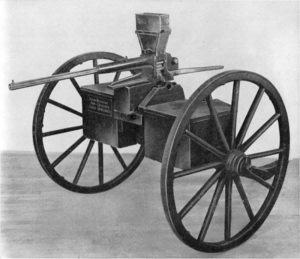 On August 17, 1861, Abraham Lincoln witnessed an exhibition of what Lincoln dubbed the “coffee mill gun.” Lincoln was always pushing for modernized weaponry beyond the standard muskets, which were inaccurate and slow to reload. He pushed Ordinance Chief James Ripley to put into service various breechloaders, rifles, carbines, and repeaters.
On August 17, 1861, Abraham Lincoln witnessed an exhibition of what Lincoln dubbed the “coffee mill gun.” Lincoln was always pushing for modernized weaponry beyond the standard muskets, which were inaccurate and slow to reload. He pushed Ordinance Chief James Ripley to put into service various breechloaders, rifles, carbines, and repeaters.
Another type of advanced weapon that Lincoln promoted was the multi-shot guns we might refer to as “machine guns.” Technically called the “Union Repeating Gun” by its salesman J.D. Mills, Lincoln dubbed one the “coffee-mill” gun due to its resemblance to that faithful brewer of morning sustenance. A single barrel was fed by bullets dropped into a hopper, then fired using a hand crank mounted on the rear. In August of 1861, Lincoln wrote Ripley: “If ten of the repeating guns, of the pattern exhibited to me this morning, by Mr. Mills, near the Washington Monument in this City, shall be well made, and furnished to the government of the U.S. within, or about thirty days from this date, I advise that the government pay for them double the sum which good mechanics of that class shall say the material, and labor of making and delivering here are worth.” Getting further concurrence of General McClellan on the potential usefulness in battle, in December Lincoln told Ripley to “let the fifty guns be ordered.”
Lincoln never stopped looking for better versions of weapons he had pushed. In the middle of 1862 Lincoln showed he understood the mechanics of repeating weapons in a letter to Stanton: “I have examined and seen tried the “Raphael Repeater” and consider it a decided improvement upon what was called the ‘Coffee Mill Gun’ in…that it is better arranged to prevent the escape of gas.” Later in the war, another repeating weapon was introduced by Dr. Richard Gatling. He claimed that “it is regarded, by all who have seen it operate, as the most effective implement of warfare invented during the war, and it is just the thing needed to aid in crushing the present rebellion” (underlining in original). To ensure no confusion with what he saw an inferior product, “I assure you my invention is no ‘coffee mill gun.’” Rather than a single barrel, the Gatling had six barrels capable of firing up to 350 rounds a minute. Repeating weapons of varying types were employed occasionally during the war, for example at Middleburg in 1862, but typically these pieces were limited to guarding locations such as bridges, being too unwieldy for infantry movements.
But Lincoln’s push for new technology went far beyond individual guns. More on that soon.
[Adapted from my forthcoming book, due out in early 2022]
David J. Kent is an avid science traveler and the author of Lincoln: The Man Who Saved America, in Barnes and Noble stores now. His previous books include Tesla: The Wizard of Electricity and Edison: The Inventor of the Modern World and two specialty e-books: Nikola Tesla: Renewable Energy Ahead of Its Time and Abraham Lincoln and Nikola Tesla: Connected by Fate.
Check out my Goodreads author page. While you’re at it, “Like” my Facebook author page for more updates!










